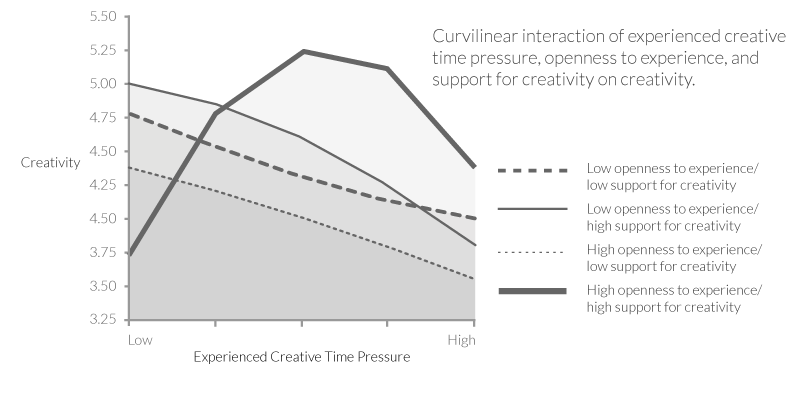
Optimizing Creativity
Substantial evidence now suggests that employee creativity makes an important contribution to organizational innovation, competitiveness, and survival (Nonaka, 1991)
In 2006, Markus Baer and Greg R. Oldham at the University of Illinois at Urbana-Champaign set out to study the relationship between experienced creative time pressure and creativity.
The study shows that the relation between creative time pressure and creativity followed an inverted U-shaped function for employees who received substantial support for creativity and who were open to experience. (Baer & Oldham, 2006)
Additional analysis revealed that in the case of high support for creativity and high openness to experience, the simple slope of the regression curve had a significant positive value for low experienced creative time pressure. (Baer & Oldham, 2006)
Support for creativity moderated the inverted U-shaped relation between creative time pressure and creativity. Specifically, employees exhibited relatively high creativity when they experienced intermediate creative time pressure AND received considerable support for creativity from supervisors and coworkers. (Baer & Oldham, 2006)
In addition to this independent moderating effect of support, the researchers found that openness to experience combined with support to further modify the curvilinear creative time pressure-creativity relation. That is, their results showed an inverted U-shaped function between time pressure and creativity for employees receiving substantial support for creativity AND scoring high on openness to experience. (Baer & Oldham, 2006)
The researchers found that only when the social environment provides the support necessary for employees to persist in their creative efforts, did openness moderate the creative time pressure-creativity relation. Under conditions of low support, low openness, or both, it is likely that individuals either do not have access to the variety of perspectives necessary to exhibit creativity when experimenting with ideas. or that they do not receive the support needed to further explore and refine their ideas. (Baer & Oldham, 2006)
Similar to earlier research, concerned with creativity in the workplace and the possible role of openness to experience and support (e.g., George & Zhou, 2001 Zhou, 2003), the results indicated that both openness to experience and support for creativity had only weak, direct relations to employee creativity but served to jointly interact w/ a contextual condition—creative time pressure—to multiplicatively affect such creativity. (Baer & Oldham, 2006)
The results, along with those obtained in earlier investigations, emphasize the importance of considering the interactive effects of contextual, social, and personality variables when examining creativity at work. (Baer & Oldham, 2006)



